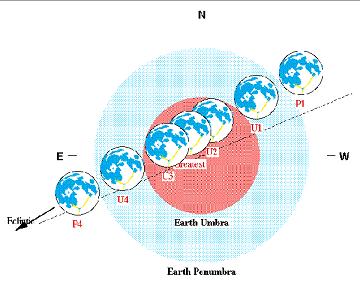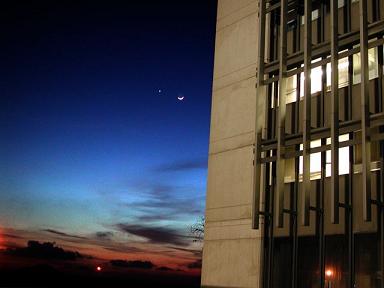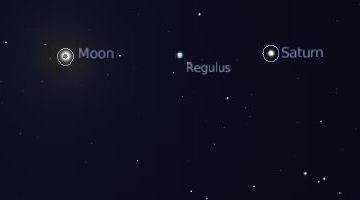Reminder: tomorrow - on March 3, the Shabbat evening of Purim will see a total white eclipse from Israel, a white eclipse occurs when the moon, receiving its light from the sun, is hidden by the shadow of the earth. This situation only occurs when the moon is full (the middle of the Hebrew month), because then the moon, the earth and the sun are on the same line
When the month of March arrives, the days get warmer, the nights get shorter and there is no lack of excellent reasons to go out and turn your eyes to the sky. A white eclipse especially for Purim, launching a shuttle to the space station and viewing planets and constellations - without going far into space.
On March 3, the Shabbat evening of Purim will see a total lunar eclipse from Israel, a lunar eclipse occurs when the moon, receiving its light from the sun, is hidden by the earth's shadow. This situation only occurs when the moon is full (the middle of the Hebrew month), because then the moon, the earth and the sun are on the same line.
Since the plane of rotation of the moon around the earth is inclined at an angle of 5 degrees relative to the plane in which the earth revolves around the sun, no birth defects or full moons occur. The condition is that in addition to the fact that the moon must be in the natal (to allow a solar eclipse) or full (to allow a lunar eclipse) it must also be very close to the plane of rotation of the earth around the sun. The Babylonians found the cycle of eclipses of the luminaries already 3000 years ago and called it "Saros" with each Saros cycle having about 74 eclipses on average (there are also cycles with over 80 eclipses). At the same time there are several saros cycles at the same time. The current eclipse is in the Saros series number 123.
The lunar eclipse will be visible, even if partially, from all the continents of the earth, but we in Israel are at the front of the stage and will be able to see the eclipse in all its stages, starting from the first moments when the moon will slowly enter the earth's shadow at 23:30 until the moon leaves the full shadow A little before 2 am Sunday morning. In the middle of the moon it will be completely hidden behind the shadow of the earth, but it will not disappear from sight! This means that the sunlight will be refracted during its passage through the earth's atmosphere - a few rays of sunset light will reach the moon and the moon will look reddish as if disguised as a tomato.

Public observations of the eclipse will be held throughout the country: The Israeli Astronomical Society is organizing two observations open to the public: in Beer Sheva - at Beit Tasif in collaboration with the Beit Tasif Astronomy Center. Images from the eclipse will be broadcast "live" on the Internet at beityatziv.co.il and at the observatory in Givatayim astronomy.org.il . Additional observations are organized at Tel Aviv University by the friend of Tel Aviv University's Astronomical Club, Tsmad Center - Young People in Science at the Weizmann Institute of Science, Technode in Givat Olga and Medatek - the National Museum of Science, Technology and Space in Haifa. *All observations depend on good weather.
In the months of spring and even summer we can observe the planet Venus which will continue to star in the early evening hours until the end of summer in August, Venus we can see right at sunset and with a little practice - even before it! The light of Nega is so bright that it is clear to Nakala why it was called that, to see it with the eye all one has to do is to look to the west in the hour after sunset - it is impossible to miss Nega. Watching through a telescope will reveal to us the amazing phenomenon of the disappearance of Venus, when its orbit brings it close to the earth, the form of the phenomenon of Venus seems like that of the moon and it can be seen growing while becoming more and more crescentic. When Galileo observed this change in the shape of Venus 397 years ago, the change in appearance of Venus was the best proof that the planets revolved around the Sun and not the Earth. On March 21, the moon will appear slightly above Venus as a bowl, another peculiarity of this day is that the duration of the daylight hours will be equal to the night, after which the nights will continue to shorten until the longest day of the year, June 21.

Mars and even the planet Hema shine in the small hours of the morning, the planet Hema which is visible in the evening until mid-late February, will be visible in the morning until the beginning of May but will only be discovered in the twilight. Mars shines a little earlier but is very far from the earth so that even with a telescope that reveals almost no details, towards December 2007 Mars will come closer to the earth and reveal a little more of its north.
The planet Jupiter shines in March late at night but is slowly getting ahead, and at the end of March Jupiter will already shine at midnight. But now, it's a shame to miss a great invitation to look at Saturn in the sky at convenient times before its rings disappear. Just as the earth's self-rotation is not perpendicular to the rotation to the plane of its orbit around the sun (that's why the manufacturers of the globes "insist" on making them curved), so is the orbit of Saturn. During 2009, Saturn's orbit around the Sun will mean that the plane of the rings will be parallel to the one where Saturn orbits the Sun, which will cause its rings to disappear, but until then they will get smaller and smaller until they disappear - so it's worth getting ahead and watching Saturn with its rings - definitely one of the wonders of the solar system . Attached is an orientation map for finding Saturn on the night of the lunar eclipse, the night before on March 2 the moon will cover Saturn, but this will happen at sunrise so that many details could not be seen, but the moon will help find Saturn.

The appearance of the sky during the lunar eclipse to an observer looking south, to the right (west) of the moon is the star Regulus, the brightest of the Leo stars, and to the west of it is Saturn, on the horizon you can see Sirius setting. Produced by stellarium software.
A little bonus, a nice activation suggestion related to the white eclipse:
The land, what is its shape?
It is not necessary to watch the entire eclipse (although it is recommended), but during the eclipse it is possible to recover an ancient insight - what is the shape and size of the earth? The knowledge that the moon orbits the earth allowed the ancients to understand the essence of white and warm eclipses and already thousands of years ago they understood that seven white eclipses by observing the shape of the shadow of the earth - you can understand what its shape is.
Experiment 1: By casting silhouettes of objects onto a board you can understand their shape, try to project silhouettes from different engineering bodies - a cube, a flat disk, a ball and an egg and compare it to the appearance of the moon at the beginning and end of the eclipse. To find the shape of the earth we will have to cast shadows from different directions on each object, which corresponds to the movement that the moon performs while revolving around the earth.
Experiment 2: Since in our day-to-day life we are used to measuring distances in centimeters, meters or a few tens of kilometers at most - astronomical distances tend to cause a terrible feeling of smallness. A walk of a few minutes pales in comparison to a 380,000-kilometer journey to the moon, not to mention the 150,000,000 kilometers to the sun (and these are other "nearby" objects). But during the eclipse we can get a fairly good idea about the Earth-Moon size ratio. All that needs to be prepared are a number of "discs", round, flat and light objects with different radii. After the eclipse begins, we can cover the Earth's shadow with a larger disc, and the moon with a smaller one (for example, a shekel/half shekel coin, discs, traffic jams, etc.), by comparing the discs we have chosen we can find the size ratio between the Earth and the Moon.

4 תגובות
Greetings ,
I am asking you to send me by email the software to download the stellarium
with gratitude
Very nice! Detailed and well explained.
Shhh, Sakhtein Amir.
worth to see…
Wow Amir, great article!!!…
Good morning to Tamar!!!